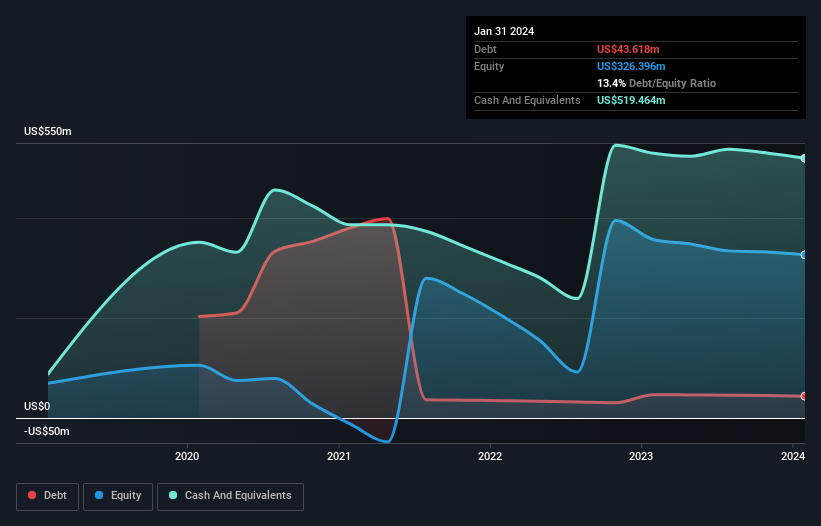Warren Buffett famously said, 'Volatility is far from synonymous with risk.' So it seems the smart money knows that debt - which is usually involved in bankruptcies - is a very important factor, when you assess how risky a company is. We note that Asana, Inc. (NYSE:ASAN) does have debt on its balance sheet. But the real question is whether this debt is making the company risky.
When Is Debt Dangerous?
Debt and other liabilities become risky for a business when it cannot easily fulfill those obligations, either with free cash flow or by raising capital at an attractive price. Part and parcel of capitalism is the process of 'creative destruction' where failed businesses are mercilessly liquidated by their bankers. However, a more common (but still painful) scenario is that it has to raise new equity capital at a low price, thus permanently diluting shareholders. Of course, plenty of companies use debt to fund growth, without any negative consequences. The first step when considering a company's debt levels is to consider its cash and debt together.
See our latest analysis for Asana
What Is Asana's Net Debt?
You can click the graphic below for the historical numbers, but it shows that Asana had US$43.6m of debt in January 2024, down from US$46.7m, one year before. But on the other hand it also has US$519.5m in cash, leading to a US$475.8m net cash position.

A Look At Asana's Liabilities
Zooming in on the latest balance sheet data, we can see that Asana had liabilities of US$367.2m due within 12 months and liabilities of US$268.4m due beyond that. On the other hand, it had cash of US$519.5m and US$88.3m worth of receivables due within a year. So its liabilities total US$27.8m more than the combination of its cash and short-term receivables.
This state of affairs indicates that Asana's balance sheet looks quite solid, as its total liabilities are just about equal to its liquid assets. So while it's hard to imagine that the US$3.31b company is struggling for cash, we still think it's worth monitoring its balance sheet. Despite its noteworthy liabilities, Asana boasts net cash, so it's fair to say it does not have a heavy debt load! There's no doubt that we learn most about debt from the balance sheet. But ultimately the future profitability of the business will decide if Asana can strengthen its balance sheet over time. So if you want to see what the professionals think, you might find this free report on analyst profit forecasts to be interesting.
Over 12 months, Asana reported revenue of US$653m, which is a gain of 19%, although it did not report any earnings before interest and tax. That rate of growth is a bit slow for our taste, but it takes all types to make a world.
So How Risky Is Asana?
Statistically speaking companies that lose money are riskier than those that make money. And the fact is that over the last twelve months Asana lost money at the earnings before interest and tax (EBIT) line. And over the same period it saw negative free cash outflow of US$31m and booked a US$257m accounting loss. While this does make the company a bit risky, it's important to remember it has net cash of US$475.8m. That kitty means the company can keep spending for growth for at least two years, at current rates. Overall, we'd say the stock is a bit risky, and we're usually very cautious until we see positive free cash flow. When analysing debt levels, the balance sheet is the obvious place to start. But ultimately, every company can contain risks that exist outside of the balance sheet. For example - Asana has 3 warning signs we think you should be aware of.
If, after all that, you're more interested in a fast growing company with a rock-solid balance sheet, then check out our list of net cash growth stocks without delay.
New: Manage All Your Stock Portfolios in One Place
We've created the ultimate portfolio companion for stock investors, and it's free.
• Connect an unlimited number of Portfolios and see your total in one currency
• Be alerted to new Warning Signs or Risks via email or mobile
• Track the Fair Value of your stocks
Have feedback on this article? Concerned about the content? Get in touch with us directly. Alternatively, email editorial-team (at) simplywallst.com.
This article by Simply Wall St is general in nature. We provide commentary based on historical data and analyst forecasts only using an unbiased methodology and our articles are not intended to be financial advice. It does not constitute a recommendation to buy or sell any stock, and does not take account of your objectives, or your financial situation. We aim to bring you long-term focused analysis driven by fundamental data. Note that our analysis may not factor in the latest price-sensitive company announcements or qualitative material. Simply Wall St has no position in any stocks mentioned.
About NYSE:ASAN
Asana
Operates a work management software platform for individuals, team leads, and executives in the United States and internationally.
Flawless balance sheet and undervalued.
Similar Companies
Market Insights
Community Narratives



